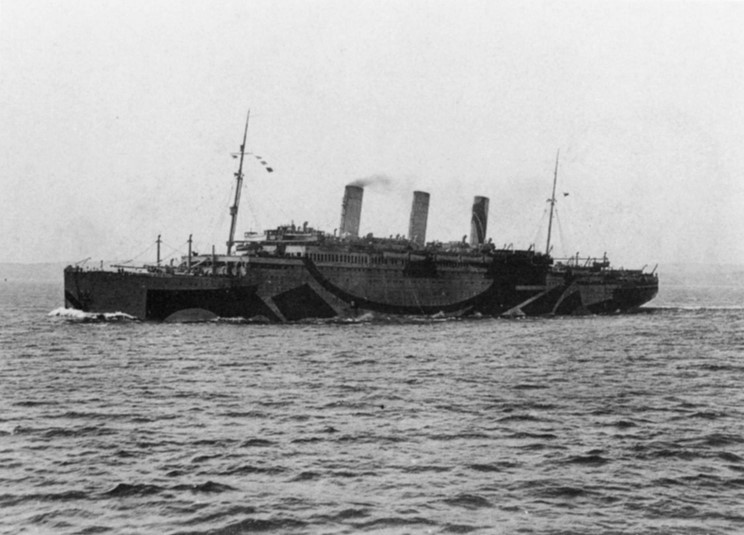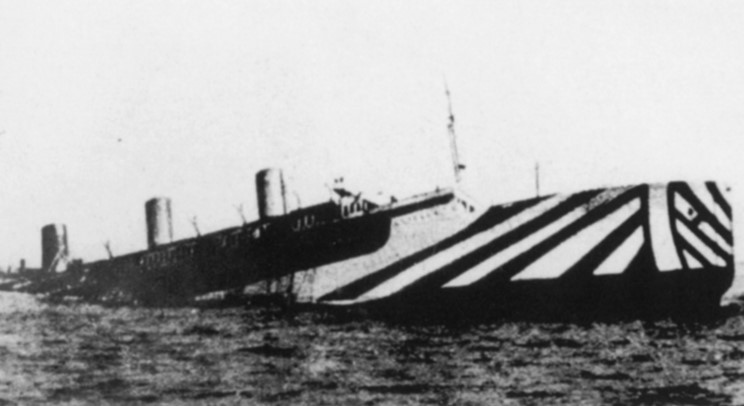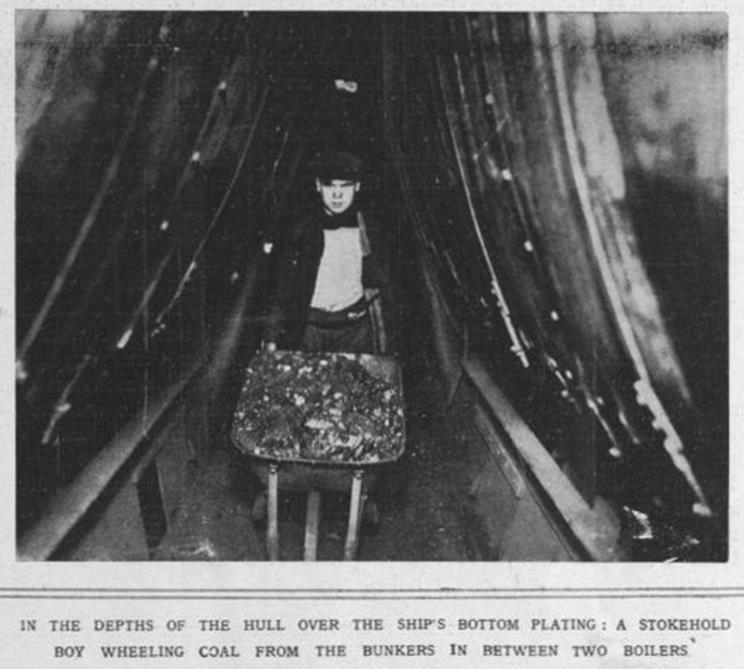|
A valiant effort to save a ship coupled with an enemy determined to sink her could be the headline for the story of the Justicia. A ship designed as a passenger liner who never saw service as such. Justicia began her life as the Holland America liner Statendam at Harland & Wolff in Belfast, she was launched as such on July 9, 1914, however by September construction was halted due to the war. In 1915 the liner was purchased by the Admiralty and it was ordered to be converted into a troopship and renamed Justicia. She was finally completed in April of 1917 and was turned over to the White Star Line, the crew from the HMHS Britannic (Titanic's sister and another passenger ship that never saw passenger service due to the war, she was requisitioned as a hospital ship before completion and sunk by a mine laid by SMS U-73 on Nov. 21, 1916 in the Aegean Sea), were assembled to man the new ship. Originally the ship was to be given to Cunard, but their inability to man her caused the Admiralty to give her to White Star. She was used at first to transport troops to and from Australia and New Zealand, even being reported sunk by the Germans in March of 1917 in the Mediterranean. The ship was then chartered by the USA to transport troops to Europe and wounded home to the USA and Canada. Under the command of Capt. A.E.S. Hambleton she had brought over an estimated 10,000 U.S. troops and was returning to New York on July 19, 1918 when in the early afternoon the SMS UB-64, commanded by Oberleutnant zur See Otto von Schrader, a veteran U-boat commander who sank 63 ships during his career, avoided the destroyer screen and fired a torpedo at the Justicia, hitting her in the engine room. The explosion killed nine men outright, a tenth would die of his wounds. The damage was assessed and the escorting destroyers began the hunt for the submarine, launching depth charges at the unseen target. Their effort failed and two hours later more torpedoes were fired by the UB-64 all of which missed, in some accounts it is claimed that up to four torpedoes were either exploded or diverted from their course by the gunners on the Justicia, others were seen passing in front of or behind the ship. It was determined that the ship was in no danger of sinking so the HMS Sonia took her in tow with the Loch Swilly being the destination, as this was the only deep water area close enough to take the ship. The torpedo attacks continued until late in the afternoon scoring two or three more hits. Having expended most but not all of his torpedoes (UBIII Type boats carried 10 torpedoes and he used at least one to sink the AMC Marmora on July 23 before returning to port), and after receiving some damage to his boat from the depth charges, Schrader retired from the fight. The next morning, July 20, 1918, the attack was on again, this time by Oberleutnant zur See Hans Oskar Wutsdorff and the SMS UB-124, this was his first command and the Justicia was the first and only ship he ever sank. While he was a new commander, his courage to attack an enemy surrounded by so many escorts (some accounts suggest there were 30 vessels surrounding the Justicia) can not be underestimated. He went in against overwhelming odds, got past all the escorts and fired several torpedoes, two hit the stricken ship. It was now clear that she would sink, the 453 man crew were removed by nearby ships and at a little after 2pm she slid beneath the waves. Wutsdorff got his first kill, but it cost him his boat. The escorting destroyers, failing to stop the attack, struck back with a vengeance. HMS Marne, HMS Milbrook and HMS Pigeon unleashed a barrage of depth charges which forced the UB-124 to the surface. When she broke the surface the gunners opened fire on the boat even as the crew were abandoning her. She sank not far from the Justicia, two of her crew were killed, the rest, including Wutsdorff were taken prisoner. In newspaper accounts of the story some of the men claimed as many as eight submarines attacked the Justicia, however it was only two, two unseen iron sharks with commanders who must have had nerves of steel to attempt such an attack. Even a naval board of enquiry which was convened stated that " the bravery and determination of the U-boats had been beyond belief." |
© 2008 Michael W. Pocock MaritimeQuest.com |
Roll of Honour |
 |
In memory of those who lost their lives in Justicia "Remember Their Names For They Died as Heroes" |
Name |
Rate |
||
Foran, Christopher |
Storekeeper |
||
Grant, Percy |
Fireman |
||
James, Thomas |
3rd Engineer (died of wounds July 20) |
||
Johnston, Maurice |
Trimmer |
||
Jones, William J. |
Trimmer |
Age 17 |
|
O'Neill, James |
Greaser |
||
Russell, Thomas |
Greaser |
||
Sutton, John W. |
Refrigerator Greaser |
||
Turner, Samuel J. |
Trimmer |
||
Watt, David |
Trimmer |
||
Gedenktafel |
 |
Zum Gedenken an die Gefallenen des Unterseeboot SMS UB-124 |
"In the memory of the fallen crewmen of the submarine SMS UB-124" |
Name |
Rank |
||
Engstfeld, Kark |
Marine Ingenieer |
||
Seevers, Paul |
Leutnant zur See
|
 |
| Justicia, date and location unknown. |
 |
| July 20, 1918 Justicia just before going under.
|
1. Apr 9, 2011 I am a 78 year old female who is originally from England. My computer knowledge is limited; however, two years ago, I was able to do a little research on the sinking of ships, during WW I, in particular, the sinking of British ships. Today, I was surfing the web, in an attempt to find out more information and, accidentally came across your site. My father, Clifford Young, at the age of sixteen (early in the year 1918) ran away from home (which was in Swinton, Lancashire, England) and joined the Merchant Navy. I have, amongst my souvenirs, a letter from my father, addressed to his parents and siblings, which was dated March 31, 1918. It is written on letter-heading stationery from The American Seamen's Friend Society, in New York. My father, in this letter, stated that he: "...went on board last Thursday night (March 21st) about six o'clock. .......... The ship that I am on is the "S.S. Justicia" and it is a duration of the war boat". The letter goes on and, if you are interested in seeing a copy, I will be happy to send one to you. When we were quite young, my father used to tell my two sisters and myself, that he was torpedoed on the above-mentioned ship, off the coast of Ireland and, this is why I started to do the research on it. I wrote a short story about what I had learned from information which I gained from my searches on the internet. I remember my father saying that there was another young boy on board who, like my father, had lied about his age in order to join the British Merchant Navy. I believe he said that they became friendly but, this friend was not as fortunate as my father, since he perished during the torpedoing of this great liner. If I remember correctly, he was a trimmer, working in the engine room, as was my father. I am writing to you, to find out if it is possibly, to obtain a list of the crew members (including the ones who survived) and their ages, who were on board that fateful twenty-four hours of July 19 - 20, 1918. I would like to give this young boy his correct name in the short story I have written about the Justicia - there are two Trimmers on your list of those who lost their lives but, I don't know which one he was. You have a count of ten crewmembers who lost their lives but, I have read the count to be sixteen from other sources. Will you clarify this for me please? Also, if I could get a list of crew-members names, I would have validity that, indeed, my father, Clifford Young (real d.o.b. July 14, 1901) was on board the Justicia, at the time that she met her doom. I wrote my story for my children and two grandchildren, ages 7 & 9 and, even at this young age, my grandson is keenly interested in hearing about his great grandfather and of his brave service in the British Merchant Navy, at the young age of sixteen. I also came across photographs and information about the German Commanders of the Kaiserliche Marine (German Imperial Navy) in particular, Otto von Schrader, who was the Commander of Unterseeboot 64 (U-boat 64) which was the U-boat which fired the first of several torpedoes which struck the "Justicia". His U-boat had received a depth-charge attack and was damaged, so he was forced to give up his quest. The torpedoes which finished the "Justicia" off, were from U-boat 124; the Commander of which, was Hans Oskar Wutsdorff. From your site, I discovered that his U-boat was sunk by one of the destroyers accompanying Justicia, that two of U-boat 124 crew members lost their lives, and the rest were taken prisoners-of- war in Derry, Ireland, including Wuttsdorff. Unfortunately, I was unable to find anything more, regarding Wutsdorff - what had happened to him after the war ended and he was freed, or even obtain a photograph of him. I was wondering if you could give me any suggestions as to where to find this information. I had no trouble getting career and even personal information on Otto von Schrader, and learned that, during WW II, he was also taken a prisoner of war and, that he committed suicide whilst he was interned. I even found out that he wasn't buried in a military cemetery worthy of a brave Kaiserliche Marine Officer but, an insignificant small, overgrown cemetery. Most of these Commanders were quite young when they were in command of these U-boats which were sinking many, many ships; for example, Otto von Schrader was only twenty-eight years of age, when Justicia was sunk. He continued sinking ships during WW II. I am so happy that I came across your website and, I am hoping that you can supply me with more information, in order that I can find out a little more detail to add to my tale. Best Regards, Jean Kelly San Diego, California |
2. Jan. 13, 2013 I was particularly interested in the letter sent to you by Jean Kelly regarding her father and his young friend on this ship. The photo below was taken aboard the Justicia before her sinking, showing a youthful crewman described as a "stokehold boy". This photo appeared in the "Illustrated London News" in 1918. I find myself wondering if this is Jean's father or the other trimmer who lost his life. Certainly he looks young enough to be 16 or 17 years old. If you are still in touch with Jean please feel free to pass this along to her. Best regards, Ralph Currell |
 |
3. Nov. 14, 2018 I am a producer working at London, UK based production company called Like A Shot Entertainment. Currently we are working on a series about shipwrecks around the world, one of the ones we are focusing on is the SS Justicia and we would really like to hear from people that had relatives either on board of the SS Justicia or were in someway present during its sinking, particularly those based in the UK. Send me an email to loubna.likeashot@gmail.com if you'd like to get in touch. Many thanks, Loubna Turjuman |
| 4. July 13, 2022 I'm working on a final edit of a writeup I did a couple of years ago pertaining to my grandfather's army service in WWI. In the process, I was revisiting a section dealing with my grandfather's Atlantic crossing aboard the Justicia, and happened to look at your site, I believe for the first time. BTW, MaritimeQuest is excellent. Kudos to you. I was particularly taken by Jean Kelly's 2011 entry. She writes of her father's letter to his family back in England written in NYC on March 31, 1918. As it turns out, Jean's father would have been passing time while waiting for my grandfather's Battalion (3rd Battalion of the 308th Regiment,) along with elements of the 307th Regiment, to arrive from Camp Upton, NY for passage to Europe. The Justicia was tied up alongside the Cretic and Lapland at North River Pier on the Hudson River to transport the entire 308th Regiment (along with part of the 307th) to Halifax, where the ships would join a small convoy to Liverpool. The three transports left NY on the morning of April 7, 1918. So Jean's young father and my grandfather (who turned 24 years of age during the trip) sailed on the same vessel to England! My grandfather's name is James Cox. We were both fortunate, as her father survived the Justicia's sinking and my grandfather survived a life-threatening machine gun wound in combat. I was also taken by Ralph Currell's photo of the teenage boy ferrying coal in the bowels of the Justicia. My goodness! What a sobering photo that is. It's hard to imagine a more vulnerable station to man in wartime. Regards, Jim Lacombe Grantham, New Hampshire |
 |